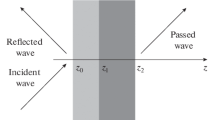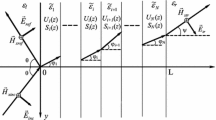Abstract
In any field theory the interaction of a wave packet with a multilayered potential is of high theoretical and practical relevance. In the present work we show an extension to any number of layers of the classical Fabry–Perot formula that works for any level of absorption, any thickness of the composing layers, any number of layers, any angle of incidence and for evanescent waves as well. More specifically, the ability of dealing with input evanescent waves and complex metal-based structures is of special interest for superlenses analysis and design. Some explicit examples in electromagnetism are also discussed.





Similar content being viewed by others
References
A. Musset, A. Thelen, Multilayer antireflection coatings. Prog. Opt. 8, 203–237 (1970)
A. Alu’, N. Engheta, Achieving transparency with plasmonic and metamaterial coatings. Phys. Rev. E 72, 016623 (2005)
M. Bellingeri, S. Longhi, F. Scotognella, Transmission of light in crystals with different homogeneity: using Shannon index in photonic media. J. Eur. Opt. Soc. Rap. Public. 5, 10041 (2010)
T.N. Fang, X. Zhang, Imaging properties of a metamaterial superlens. Appl. Phys. Lett. 82, 161–163 (2003)
M. Fujii, W. Freude, J. Leuthold, Numerical prediction of minimum sub-diffraction-limit image generated by silver surface plasmon lenses. Opt. Express 16, 21039–21052 (2008)
N. Fang, H. Lee, C. Sun, X. Zhang, Sub-diffraction-limited optical imaging with a silver superlens. Science 308, 534–537 (2005)
D.O.S. Melville, R.J. Blaikie, Super-resolution imaging through a planar silver layer. Opt. Express 13, 2127–2134 (2005)
T. Taubner, D. Korobkin, Y. Urzhumov, G. Shvets, R. Hillenbrand, Near-field microscopy through a SiC superlens. Science 313, 1595 (2006)
O. El Gawhary, N.J. Schilder, A.C. Assafrao, S.F. Pereira, H.P. Urbach, Restoration of s-polarised evanescent waves and subwavelength imaging by a single dielectric slab. New J. Phys. 14, 053025 (2012)
J.M. Bendickson, J.P. Dowling, M. Scalora, Analytic expressions for the electromagnetic mode density in finite, one-dimensional, photonic band-gap structures. Phys. Rev. E 53, 4107–4121 (1996)
R. Chifahi, R. Mountasser, A. Taouri, Analysis of the optical transmission through a nonlinear thin layer near the critical angle of incidence. J. Eur. Opt. Soc. Rap. Public. 6, 11023 (2011)
M.G. Moharam, D.A. Pommet, E.B. Grann, T.K. Gaylord, Stable implementation of the rigorous coupled-wave analysis for surface-relief gratings: enhanced transmittance matrix approach. J. Opt. Soc. Am. A 12, 1077–1086 (1995)
Q. Cao, P. Lalanne, J.-P. Hugonin, Stable and efficient Bloch-mode computational method for one-dimensional grating waveguides. J. Opt. Soc. Am. A 19, 335–338 (2002)
R. Uitham, B. Hoenders, Transmission coefficient of a one-dimensional layered medium from a light-path sum. J. Eur. Opt. Soc. Rap. Public. 3, 08013 (2008)
W.J. Hsueh, J.C. Lin, Stable and accurate method for modal analysis of multilayer waveguides using a graph approach. J. Opt. Soc. Am. A 24, 825–830 (2007)
L. Li, Note on the S-matrix propagation algorithm. J. Opt. Soc. Am. A 20, 655–660 (2003)
D.Y.K. Ko, J.R. Sambles, Scattering matrix method for propagation of radiation in stratified media: attenuated total reflection studies of liquid crystals. J. Opt. Soc. Am. A 5, 1863–1866 (1988)
L. Li, Formulation and comparison of two recursive matrix algorithms for modeling layered diffraction gratings. J. Opt. Soc. Am. A 13, 1024–1035 (1996)
E.L. Tan, Note on formulation of the enhanced scattering- (transmittance-) matrix approach. J. Opt. Soc. Am. A 19, 1157–1161 (2002)
L. Novotny, B. Hecht, Principles of Nano-Optics, Cambridge University Press, Cambridge (2006)
M. Born, E. Wolf, Principles of Optics, 7th(expanded) ed., Cambridge University Press, Cambridge (2001)
Author information
Authors and Affiliations
Corresponding author
Appendix 1: energy conservation
Appendix 1: energy conservation
In this appendix we recall some expressions for the Poynting vectors of the incident, reflected and transmitted fields. They are used to check that the analytical expression for the transmitted and reflected fields, as derived in the paper, do not violate the energy conservation every time we are in the presence of a non-dissipative system.
When the incident wave has the x component of the wave vector different from zero (i.e., we are not at normal incidence) the expression of energy conservation can be obtained by deriving the expression of the z component of the Poynting vectors for the incident, reflected and transmitted wave, respectively. In addition, this has to be done separately for s- and p-polarization. Let us start with the s-polarization case.
1.1 S-polarization case
Let us assume that the incident wave has an electric field component of type
with k (i) = (k (i) x , 0, k (i) z ) the wave vector of the incident field and r = (x, y, z). The energy flow along z for the incident field can be written, starting from the definition of the Poynting vector as
We need to look at the z component for the incident, reflected and transmitted field. After simple algebra we obtain,
where ω is the angular frequency and μ i is magnetic permeability of the input medium i. For the Poynting vectors of the reflected and transmitted field we get,
(k (r) z = k (i) z and μ i = μ r , since incident and reflected wave lie in the same medium),
with obvious meaning of the notation. To check energy conservation, we look at the following normalized quantity
that should always (i.e., for all k x ) be equal to one for absorption-free systems. In case k (i) x = 0 (normal incidence), in absence of absorption and with same input and output medium, Eq. 17 reduces to the well-known form |r s |2 + |t s |2 = 1.
1.2 P-polarization case
In this case it is easier to consider the y component of the incident magnetic field
For the z component of the Poynting vector of the incoming field we obtain
All formulas derived in the previous subsection can be extended to the current case by replacing r s and t s by r p and t p and μ by \(\varepsilon\) in the medium. After doing that we get
which represents the energy conservation formula for the p-polarization case.
Rights and permissions
About this article
Cite this article
Gawhary, O.E., Dheur, M.C., Pereira, S.F. et al. Extension of the classical Fabry–Perot formula to 1D multilayered structures. Appl. Phys. B 111, 637–645 (2013). https://doi.org/10.1007/s00340-013-5390-9
Received:
Revised:
Published:
Issue Date:
DOI: https://doi.org/10.1007/s00340-013-5390-9




